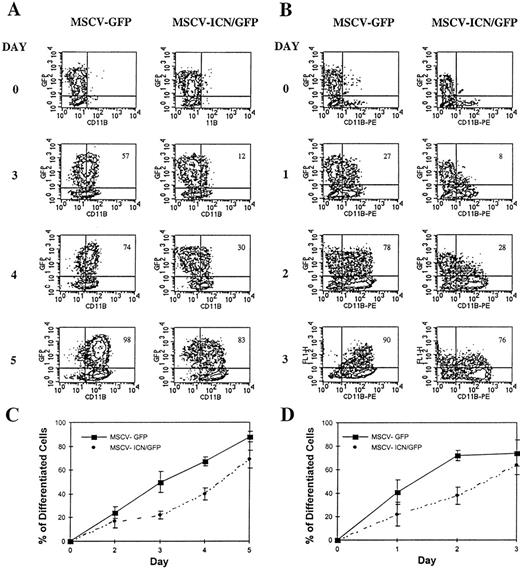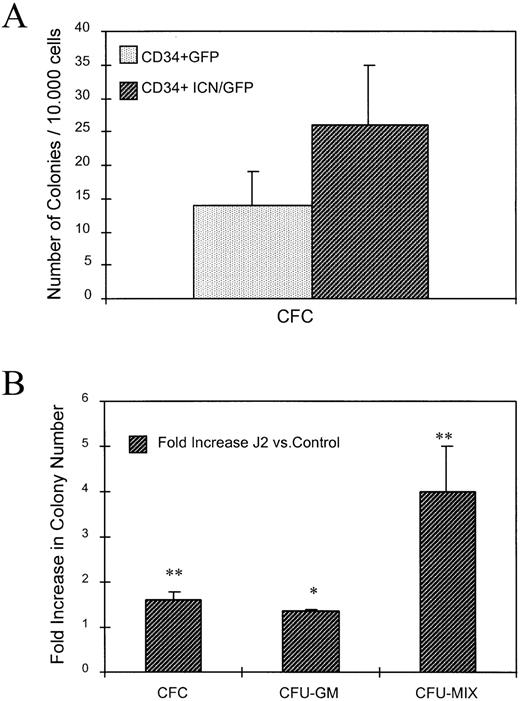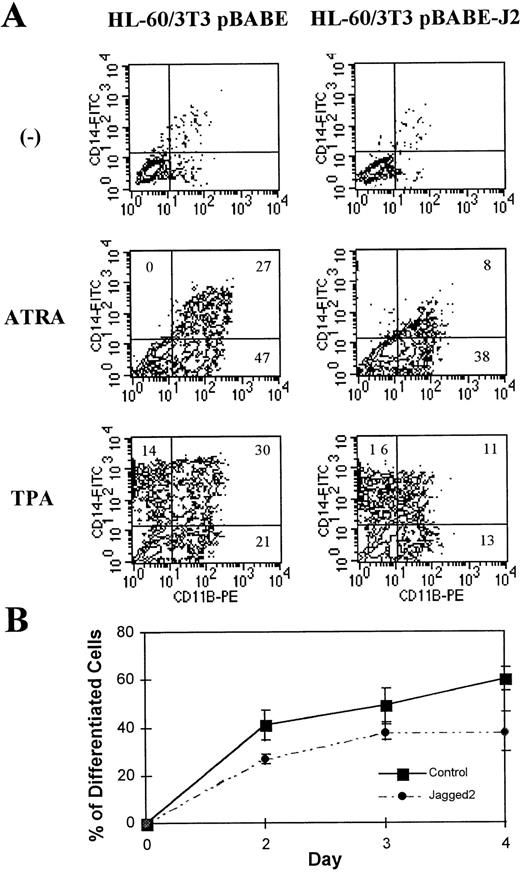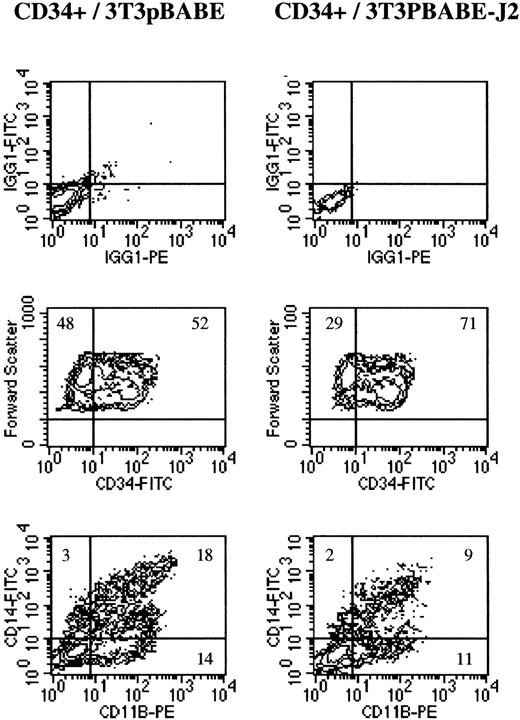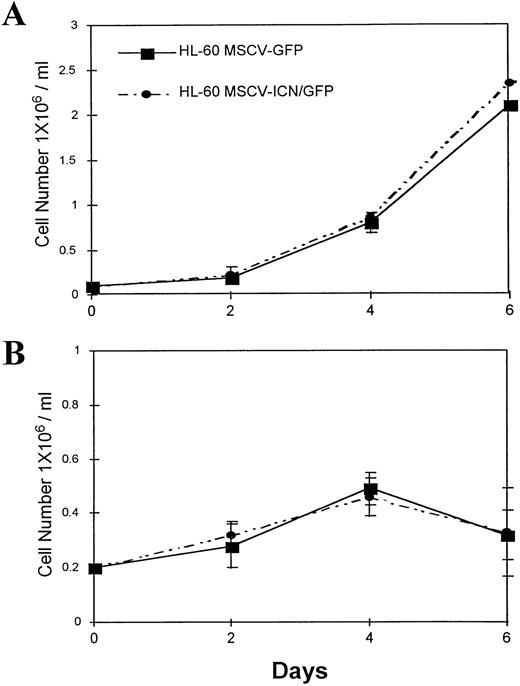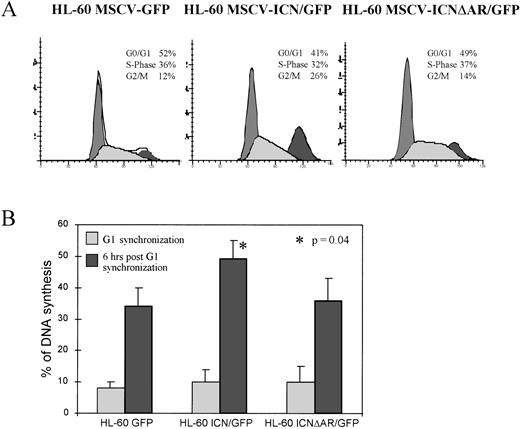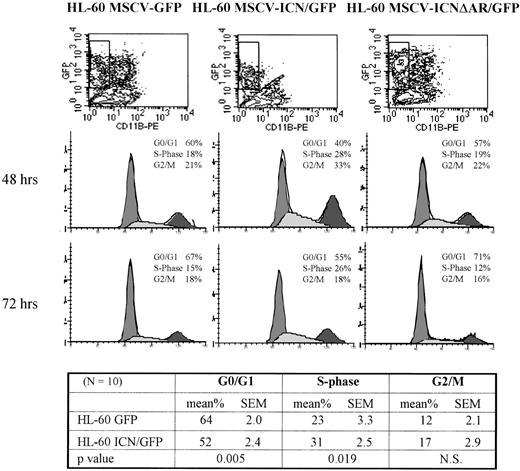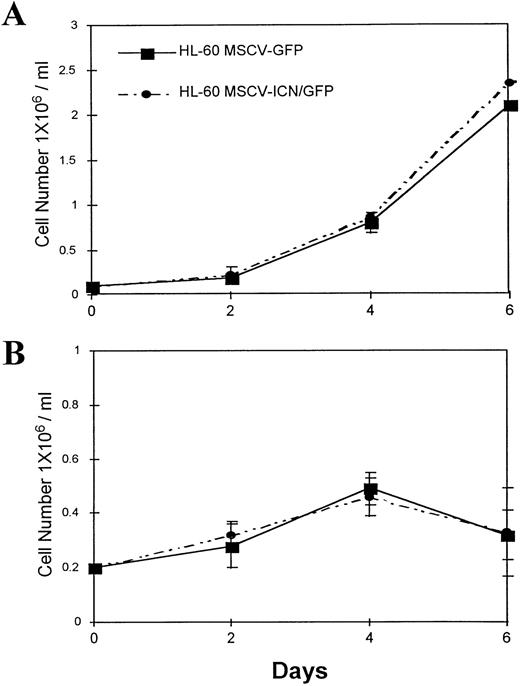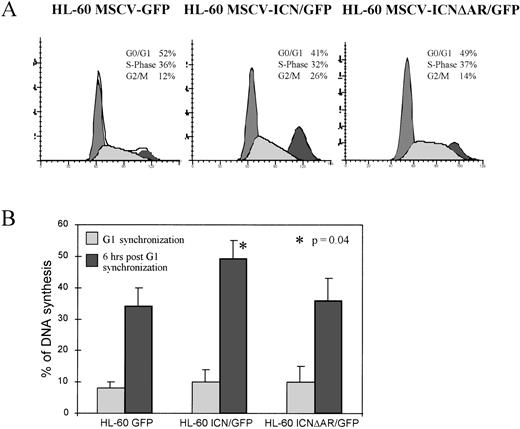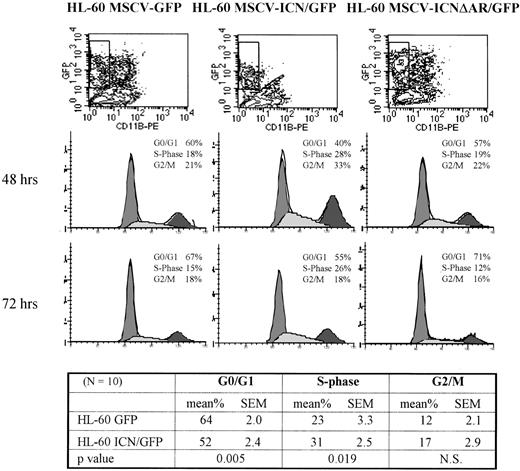Abstract
Hematopoiesis is a balance between proliferation and differentiation that may be modulated by environmental signals. Notch receptors and their ligands are highly conserved during evolution and have been shown to regulate cell fate decisions in multiple developmental systems. To assess whether Notch1 signaling may regulate human hematopoiesis to maintain cells in an immature state, we transduced a vesicular stomatitis virus G-protein (VSV-G) pseudo-typed bicistronic murine stem cell virus (MSCV)-based retroviral vector expressing a constitutively active form of Notch1 (ICN) and green fluorescence protein into the differentiation competent HL-60 cell line and primary cord blood–derived CD34+ cells. In addition, we observed endogenous Notch1 expression on the surface of both HL-60 cells and primary CD34+ cells, and therefore exposed cells to Notch ligand Jagged2, expressed on NIH3T3 cells. Both ligand-independent and ligand-dependent activation of Notch resulted in delayed acquisition of differentiation markers by HL-60 cells and cord blood CD34+ cells. In addition, primary CD34+cells retained their ability to form immature colonies, colony-forming unit–mix (CFU-mix), whereas control cells lost this capacity. Activation of Notch1 correlated with a decrease in the fraction of HL-60 cells that were in G0/G1phase before acquisition of a mature cell phenotype. This enhanced progression through G1 was noted despite preservation of the proliferative rate of the cells and the overall length of the cell cycle. These findings show that Notch1 activation delays human hematopoietic differentiation and suggest a link of Notch differentiation effects with altered cell cycle kinetics.
BLOOD CELL DEVELOPMENT is a process of highly regulated proliferation and differentiation during which a small number of multipotent cells are sequentially recruited to generate tens of billions of mature circulating cells daily. Organization of the bone marrow includes stem cells that are capable of self renewal with some daughter cells differentiating into highly proliferative precursor cells ultimately yielding the cellular components of blood.1,2 Acquisition of lineage-specific differentiation features is associated with an irreversible loss of multipotentcy and declining proliferative potential. A common model of hematopoietic regulation poses differentiation as inversely related to proliferative capacity as cells pass through the intermediate stages of blood cell maturation. The pool of highly proliferative precursor cells responds to physiological stress with consequent expansion in the numbers of differentiated mature blood elements. The proliferation of this precursor pool has been shown to be induced by cytokines, many of which also have prodifferentiative effects. However, the spectrum of action of cytokines is broad, with cytokines such as kit ligand and flt-3 ligand enhancing survival of primitive cells as a function distinct from that of augmenting proliferation.3 4 Because the maintenance of a primitive precursor cell population is critical for amplification of proliferation, it may be hypothesized that there are also regulated environmental cues within hematopoietic tissue that impede differentiation. These signals may be envisioned to delay acquisition of a terminally differentiated phenotype, thereby permitting ongoing proliferation.
One signaling pathway that seems likely to affect the balance between proliferation and differentiation involves Notch, which has been shown to influence the cell fate of diverse types of progenitor cells in a wide range of multicellular animals. Notch genes encode large, highly conserved type 1 transmembrane glycoprotein receptors composed of a series of iterated structural motifs, including epidermal growth factor (EGF)-like repeats that have been implicated in ligand binding and an intracellular ankyrin-like repeat region that is critical for downstream signaling events.5 Physiological activation of Notch signaling occurs through binding of one of a series of ligands, such as Jagged1, Jagged2, and Delta, that are also transmembrane proteins.6-11 Of the four Notch genes described thus far in vertebrates,12-15 most studies have been conducted with Notch1, which was originally identified as a gene that is rearranged by a recurrent (7;9) chromosomal translocation associated with a subset of human T lymphoblastic leukemias.16 Subsequent studies have shown that constitutive activation of Notch1 results in blocked differentiation and expansion of chick retinal precursor cells7,17 and in the prevention of murine myoblast8 and neuroblast differentiation.18 Recent studies also suggest a physiological role for Notch1 in the regulation of hematopoiesis. Notch1 is expressed by CD34+ bone marrow progenitor cells,19 and at least one Notch1 ligand, Jagged1, is expressed by marrow stromal cells.11 Activation of Notch1 has recently been shown to result in the inhibition of granulocytic differentiation of murine cells.11 19
Normal cell differentiation is thought to primarily occur through cell functions accomplished in the G0 /G1 phase of the cell cycle.20-24 Conversely, disruption of cell cycle checkpoints has been associated with perturbed proliferation and differentiation, as shown by cancer cells. As constitutively active forms of Notch1 have the capacity to inhibit differentiation and act as oncoproteins,25 26 we hypothesized that these effects might be mediated, at least in part, through altered regulation of the cell cycle. In this study, we show that Notch1 activation by either transduction of an activated form or through cognate ligand stimulation has the ability to delay the differentiation of human HL-60 cells and primary CD34+ progenitor cells, and that this effect correlates with shortening of the G1 phase of the cell cycle.
MATERIALS AND METHODS
cDNA expression constructs.
cDNAs encoding a constitutively active form on Notch1 consisting of the intracellular domain (base pairs [bp] 5308-7665; amino acids [aa] 1770-2555; ICN) or an inactive form on ICN with a deletion removing the coding sequence of the ankyrin repeat region (deletion bp 5570-6618; aa 1859-2207; ICNΔAR)27 were subcloned into the multicloning site of the retroviral vector MSCV-GFP28(Fig 1A). As the result of an internal ribosomal entry sequence and a cDNA encoding enhanced green fluorescent protein (GFP; Clontech Laboratories, Palo Alto, CA) that lie 3′ of the multicloning site, the 5′ long terminal repeat promoter of this vector drives the expression of a single biscistronic mRNA encoding both Notch1 polypeptides and GFP.
Retroviral constructs and transduction. (A) Structure of Notch1 and ICN and of the retroviral vector MSCV 2.2. (▪), hydrophobic leader; (▩), EGF-like repeats; (▨), LNR repeats; (‖▪‖), transmembrane domain; (▧), ankyrin repeats; Q, glutamine-rich region; P, PEST sequence. The MSCV LTR, IRES motif, and GFP gene of the MSCV 2.2 vector are indicated. (B) Flow cytometric analysis for GFP in HL-60–transduced cells. Contour plots represent fluorescence intensity for GFP on the x-axis and cell forward scatter on the y-axis. (C) Flow cytometric analysis for Notch1 on gated HL-60 and CD34+ GFP-positive cells. The polyclonal antibody directed against the intracytoplasmatic region of Notch1, T3, was used as described. Histograms are expressed as fluorescence intensity for Notch1 on the x-axis (log scale) and cell count on the y-axis. Superimposed are fluorograms with anti-GST control antibody on MSCV-GFP cells (left, filled curve), anti-T3 antibody on MSCV-GFP cells (middle curve, solid line), and anti-T3 antibody on MSCV-ICN/GFP cells (right curve, dotted line). Fluorograms with anti-T3 antibody on MSCV-GFP cells and uninfected cells were superimposable.
Retroviral constructs and transduction. (A) Structure of Notch1 and ICN and of the retroviral vector MSCV 2.2. (▪), hydrophobic leader; (▩), EGF-like repeats; (▨), LNR repeats; (‖▪‖), transmembrane domain; (▧), ankyrin repeats; Q, glutamine-rich region; P, PEST sequence. The MSCV LTR, IRES motif, and GFP gene of the MSCV 2.2 vector are indicated. (B) Flow cytometric analysis for GFP in HL-60–transduced cells. Contour plots represent fluorescence intensity for GFP on the x-axis and cell forward scatter on the y-axis. (C) Flow cytometric analysis for Notch1 on gated HL-60 and CD34+ GFP-positive cells. The polyclonal antibody directed against the intracytoplasmatic region of Notch1, T3, was used as described. Histograms are expressed as fluorescence intensity for Notch1 on the x-axis (log scale) and cell count on the y-axis. Superimposed are fluorograms with anti-GST control antibody on MSCV-GFP cells (left, filled curve), anti-T3 antibody on MSCV-GFP cells (middle curve, solid line), and anti-T3 antibody on MSCV-ICN/GFP cells (right curve, dotted line). Fluorograms with anti-T3 antibody on MSCV-GFP cells and uninfected cells were superimposable.
Retroviral transduction.
MSCV-GFP vectors were cotransfected into 293T cells using a calcium phosphate precipitation method25 29 with pKat (kindly provided by M. Finer, Cell Genesys Inc, Foster City, CA), an amphotropic packaging plasmid, and pCMV-VSV-G, a plasmid encoding the vesicular stomatitis virus G-glycoprotein (kindly provided by T. Friedmann, University of San Diego, CA). Supernatants containing pseudo-typed retrovirus were collected at 48 and 72 hours and were used to infect primary CD34+ cells and the HL-60 cell line.
CD34+ progenitors were cultured in Iscove’s modified Dulbecco’s medium (IMDM) (Mediatech Inc, Harndon, VA) containing 10% fetal calf serum (FCS; Sigma, St Louis, MO) (IMDM 10) supplemented with Kit ligand (KL; 50 ng/mL), thrombopoietin (TPO; 20 ng/mL), FLT3 ligand (FLT-3 L; 50 ng/mL), and interleukin-3 (IL-3; 50 ng/mL) (R & D, Minneapolis, MN) for 48 hours before infection, to induce cells to enter into cell cycle. Stimulated CD34+ cells or HL-60 cells were washed in phosphate-buffered saline (PBS; Sigma) and resuspended at the concentration of 1 to 2 × 105/mL in 1 mL of 80% retroviral supernatant and 20% fresh complete medium plus Polybrene (final concentration, 8 μg/mL; Sigma). Cells in suspension were placed in a 48-well plate (Becton Dickinson Inc, Franklin Lakes, NJ), spinoculated at 1,700 revolutions per minute for 50 minutes, then incubated at 37°C 5% CO2 for an additional 6 to 8 hours, washed, and resuspended in fresh medium overnight. A second and a third infection were conducted on the following days using an identical procedure. Infection efficiency was evaluated by GFP expression 4 days after the last infection. ICN and ICNΔAR overexpression was also determined using the T3 antibody against Notch1.30 In some experiments, GFP-positive cell enrichment was performed by fluorescence-activated cell sorting (FACS Vantage; Becton Dickinson, San Jose, CA).
Cells and cell culture.
Cord blood samples were obtained from the Pediatric Research Institute, University of St Louis, MO, according to the guidelines established by the Human Investigation Committee. Mononuclear cells were separated by Ficoll-Hypaque (Pharmacia-Biotech, Uppsala, Sweden) density gradient centrifugation, and CD34+ cells purified by immunomagnetic bead selection (Milteny Biotec, Auburn, CA), according to the manufacturer’s instructions. Transduced CD34+ cells were grown in IMDM 10 supplemented with KL (20 ng/mL), FLT-3 L (20 ng/mL), and IL-3 (50 ng/mL; R & D) or PIXY 321 (50 ng/mL; Immunex, Seattle, WA). Cells were initially cultured in 0.2 mL final volume at the density of 0.5 to 1 × 106/mL in 96-well plate wells. Fresh media and cytokines were added every 3 to 4 days and cells were subsequently transferred to 24-well plates (Becton Dickinson Labware) to maintain the initial density.
The promyelocytic cell line HL-60 was obtained from American Type Culture Collection (Rockville, MD). HL-60 and HL-60–transduced cell lines were maintained in RPMI medium supplemented with 10% FCS (R10). To induce HL-60 cells to differentiate, 1 to 2 μmol/L all-trans-retinoic acid (ATRA; Sigma) or 2 to 4 nmol/L tetrahydro-phorbol-ester acid (TPA; Sigma) were added to R10. In these experiments, cells were cultured in 1 mL of R10 with or without inducing agents in 24-well plate wells; an equal volume of fresh medium was added at day 3 of culture.
Human embryonic kidney–derived 293T cells and murine NIH-3T3 cells were grown in Dulbecco’s modified Eagle’s medium supplemented with 10% FCS (D10). CD34+ cells, HL-60 cells, and NIH3T3 cells were cultured at 37°C under 5% CO2, whereas 293T cells were cultured at 33°C under 5% CO2. For coculture experiments, 3T3pBABE and 3T3pBABE-Jagged2 cells10 were cultured in 24-well plate wells to approximately 70% of confluence. Medium was then aspirated and the monolayers rinsed gently with PBS before adding 2 mL of HL-60 or CD34+ cell suspension at the density of 0.1 × 106/mL. ATRA, TPA, or medium was added to the 3T3/HL-60 cocultures while 3T3/CD34+cocultures were supplemented with FLT-3 L (20 ng/mL) and PIXY (20 ng/mL). Half of the medium volume was replaced every 3 days with fresh medium. During 3T3/CD34+ cell cocultures, primary cells were split and transferred from their 3T3 monolayers onto fresh monolayers (70% confluent) every 5 to 6 days. Before analysis, HL-60 or CD34+ cells were detached from the feeder layer either by vigorous pipetting or by EDTA treatment (no differences were noted when the two methods were compared) and subsequently washed in R10 medium.
Clonogenic progenitor assays were performed with cells obtained from the liquid cultures or the 3T3 cocultures. Harvested cells were cultured in methylcellulose (Stem Cell Technologies, Vancouver, British Columbia, Canada) supplemented with IL-3 (50 ng/mL), KL (50 ng/mL), and erythropoietin (EPO; 2 U/mL; Amgen, Thousand Oaks, CA) according to the manufacturer’s recommendations. Colonies were evaluated by phase microscopy and scored according to standard morphologic criteria after 14 days.
Antibodies.
Production, purification, and characterization of polyclonal rabbit antibodies against a portion of the intracellular domain of Notch1 defined as T3 (aa 1763-1877), the Notch ligand Jagged2 (J2), and glutathione S-transferase (GST) have been previously described.10 30 Intracellular staining was performed using fixing and permeabilization solutions (Fix and Perm) from Caltag (Burlingame, CA), according to manufacturer’s instructions. Antibodies against T3, J2, and GST were added to permeabilized cells at the concentration of 5 μg/mL for 30 minutes at room temperature. Cells were than washed twice and incubated with the monoclonal antibody (MoAb) goat anti-rabbit conjugated to phycoerythrin (PE; Sigma) (1 μg/mL).
Fluoroisothiocyanate (FITC) and PE-conjugated MoAbs directed against CD11b, CD14, CD15, and CD34 (Becton Dickinson) were used to analyze differentiation. Cells were incubated with 0.5% human IgG (Sigma) in PBS for 20 minutes at 4°C to block the Fc receptor before staining with antigen-specific antibodies. Flow cytometric analysis was performed using the FACScalibur instrument (Becton Dickinson).
Cell cycle analysis.
Cell cycle analysis was performed using the DNA binding dye TOPRO-3 (Molecular Probes, Eugene, OR). The emission spectrum of TOPRO-3 permits its use in conjunction with other fluorochromes. Three-color analysis of GFP, TOPRO-3, and PE-conjugated antibodies was performed simultaneously by flow cytometry. Cells stained with PE-conjugate antibodies were fixed in PBS 1% formaldehyde for 30 minutes, permeabilized in 0.1% Triton X-100 (Sigma) for 30 minutes at room temperature, washed, and resuspended in a PBS 1 mg/mL RNAse (Sigma) and 1 μg/mL TOPRO-3 for a minimum of 30 minutes at 4°C before FACS analysis.
Cell cycle synchronization experiments were conducted on HL-60–transduced cells enriched for GFP (to 95% purity) by cell sorting. Cells were incubated with hydroxyurea (10 mmol/L) or nocodazol (200 ng/mL; Calbiochem Inc, La Jolla, CA) for 22 hours in R10. Then, cells were washed twice with PBS and incubated in the fresh medium without hydroxyurea or nocodazol. Cell cycle profiles were analyzed by bromodeoxyuridine (BrdU; Sigma) incorporation every 6 hours for the following 24 hours. BrdU-pulsed cells were fixed in 70% ethanol at −20°C overnight and denatured by 2 N HCl, 0.5% Triton X-100 for 30 minutes at room temperature, followed by neutralization with borate buffer (pH 8.5). Treated cells were subjected to dual-color staining with anti-BrdU MoAb (Becton Dickinson) followed by goat anti-mouse FITC-conjugated and 5 μg/mL propidium iodide. Analyses were performed using the FACSCalibur flow cytometer, and Cell Quest and Modefit software (Becton Dickinson).
Statistical analysis.
Equality of distributions for matched pairs of observations were tested using the Wilcoxon matched-pairs signed ranks test. The analyses were performed using the software STATA (r) (Stata Corporation, College Station, TX).
RESULTS
The following two approaches were used to evaluate the effects of human Notch1 on human hematopoiesis: (1) ligand-independent activation using retroviral constructs driving the expression of a constitutively active form of Notch1, termed ICN, and (2) ligand-dependent activation of endogenous Notch1 using NIH 3T3 feeder cells engineered to express the physiological ligand, Jagged2.10 To facilitate the former approach, we used the retroviral vector MSCV-GFP, which is known to drive high-level expression in hematopoietic progenitor cells and has an internal ribosomal entry sequence that permits expression of cDNAs of interest and a marker protein, GFP, from a single bicistronic mRNA.
To begin to investigate the effects of Notch1 activation on the differentiation of human hematopoietic cells, we used the myeloid cell line HL-60, which is capable of both granulocytic or monocytic differentiation,31 as well as CD34+ primary cells isolated from human cord blood. Differentiation toward the myeloid lineage was evaluated by determining CD11b and CD14 expression, surface markers that correlate with granulocytic and monocytic differentiation.32-34
Expression of endogenous Notch1 and activated Notch1 in HL-60 cells and CD34+ progenitor cells.
The efficiency of infection of HL-60 cells and CD34+progenitor cells by MSCV-ICN/GFP or empty MSCV-GFP retroviruses (Fig1A) was assessed by flow cytometric analysis; results of a representative experiment are shown in Fig 1B. Independent experiments (n = 4) showed a mean infection efficiency of 42% and 39% with MSCV-GFP or MSCV-ICN/GFP retroviruses, respectively, for HL-60 cells. Infection efficiency was more variable in CD34+ cells, ranging from 5% to more than 30% of cells stably expressing GFP. To assess expression of endogenous Notch1 and transduced ICN, flow cytometric analysis was also performed after staining with affinity-purified anti-Notch1 (Fig 1C). Both HL-60 cells and CD34+ progenitor cells infected with MSCV-GFP expressed endogenous Notch1, as shown by a shift in mean fluorescent staining intensity with anti-Notch1 as compared with anti-GST control polyclonal IgG. Overexpression of ICN by MSCV-ICN/GFP–transduced cells was shown by a further increase in the mean intensity of fluorescence (MIF).
Constitutively active Notch1 inhibits differentiation of HL-60 cells and CD34+ progenitor cells.
Evaluation of the effect of constitutively active ICN was first studied in HL-60 cells by following the induction of CD11b expression in the presence of the granulocytic differentiation agent ATRA or in the presence of the monocytic differentiation agent, TPA. HL-60 cells transduced with MSCV-GFP or MSCV-ICN/GFP were plated at equal density and induced with ATRA or TPA. A consistent delay in CD11b expression acquisition was evident in the MSCV-ICN/GFP–transduced cells compared with MSCV-GFP in multiple independent experiments (n = 4), as shown in Fig 2. In a representative experiment, on ATRA stimulation (Fig 2A), at day 3 and 4 of culture only 12% and 30% of HL-60 MSCV-ICN/GFP cells expressed CD11b, compared with 57% and 74% of HL-60 MSCV-GFP cells. By day 5, the HL-60 MSCV-CN/GFP cells expressing CD11b increased in number and resembled that of control cultures (92% v 98%). Figure 2C summarizes the results of four experiments in the presence of ATRA. Similar results were observed when cells were cultured in the presence of TPA. Upon TPA stimulation (Fig 2B), at day 1 and 2 of culture, 8% and 28% of HL-60 MSCV-ICN/GFP cells expressed CD11b, compared with 27% and 78% of HL-60 MSCV-GFP control. By day 3, most of the HL-60 MSCV-ICN/GFP cells also expressed CD11b. Figure 2D summarizes the results of two experiments. It should be noted that in each experiment, the differentiation of MSCV-ICN/GFP–infected cells lagged behind that of nontransduced GFP-negative cells in the same culture, which constitutes an internal control. In contrast to the results observed with ICN, introduction of an inactive form of Notch1 bearing a deletion that spans the ankyrin repeats, ICNΔAR, had no effect on differentiation in response to either agent (data not shown).
Effects of activated Notch1 on the differentiation of HL-60 cells. Two-color flow cytometric analysis for GFP and CD11b on transduced HL-60 cells in the absence (day 0) and in the presence of 1 μm ATRA (A and C) or 4 nm TPA (B and D). At each time point, cells were harvested, washed, and labeled with anti-CD11b PE-conjugated MoAb and analyzed by FACS. Contour plots (A and B) represent fluorescence intensity for CD11b on the x-axis and for GFP on the y-axis. Values in the line graphics (C and D) represent the mean percentage of CD11b-expressing cells in the GFP-positive population in four (C) and two (D) independent experiments. Bars represent standard error.
Effects of activated Notch1 on the differentiation of HL-60 cells. Two-color flow cytometric analysis for GFP and CD11b on transduced HL-60 cells in the absence (day 0) and in the presence of 1 μm ATRA (A and C) or 4 nm TPA (B and D). At each time point, cells were harvested, washed, and labeled with anti-CD11b PE-conjugated MoAb and analyzed by FACS. Contour plots (A and B) represent fluorescence intensity for CD11b on the x-axis and for GFP on the y-axis. Values in the line graphics (C and D) represent the mean percentage of CD11b-expressing cells in the GFP-positive population in four (C) and two (D) independent experiments. Bars represent standard error.
To extend these observations to primary marrow progenitor cells, the effect of constitutively activated Notch1 on the differentiation of CD34+ cells was studied in liquid culture. CD34+ cells infected with MSCV-GFP and MSCV-ICN/GFP grown in the presence of 10% FCS and the cytokines KL, FLT-3 L, and IL-3 or PIXY were harvested at different time points and stained with MoAbs directed against CD34, CD11b, and CD14. CD34+ cells infected with MSCV-ICN/GFP showed consistently lower expression of CD11b and CD14 markers compared with CD34+ population infected with the control vector MSCV-GFP. Table 1 shows the mean percentage of CD11b and CD14 expression in cultured cells from six experiments: at day 18, 23% of MSCV-ICN/GFP–positive cells expressed CD11b and 19% expressed CD14, whereas 49% of the MSCV-GFP–positive cells expressed CD11b and 33% expressed CD14 (P = .04 and P = .06, respectively) (Table 1). Expression of CD11b and CD14 in the GFP-negative cells in both types of cultures did not differ from that observed in the MSCV-GFP–transduced control cells (not shown), indicating that the observed difference in expression of differentiation markers was confined to the MSCV-GFP/ICN–transduced cell population.
To further assess the effect of ICN on the phenotype of progenitor cells, we performed methylcellulose colony-forming assays as a measure of a functional level of differentiation. We evaluated the colony-forming ability of the cultured cells in three samples that showed a high efficiency of transduction (approximately 30%). After 2 weeks of liquid culture, cells were replated at 10,000 cells/mL in methylcellulose. CD34+ cells infected by MSCV-ICN/GFP gave rise to a significantly higher number of colony-forming cells (CFC) compared with CD34+ cells infected with MSCV-GFP (P= .03). CFC included colony-forming unit–granulocyte/macrophage (CFU-GM), CFU-G, and CFU-M; CD34+ MSCV-ICN/GFP also generated burst-forming units–erythroid (BFU-E) in some but not all experiments. Figure 3A shows average colony number in three independent experiments. After 2 weeks in culture, progenitors infected with MSCV-ICN/GFP gave rise to an approximately twofold increase in CFC compared with controls (mean, 26 SEM ± 5v mean, 14 SEM ± 4/10,000 cells). Thus, Notch1 activation decreased the fraction of differentiated cells as measured by immunophenotype and function, preserving progenitor cells in a state of higher potentiality.
Effects of Notch activation on colony-forming ability of primary hematopoietic progenitors. (A) CD34+ MSCV-GFP and MSCV-ICN/GFP cells were grown in liquid culture in presence of cytokines. After 2 weeks, cells were obtained and plated in triplicate, at a density of 10,000 cells/mL in methylcellulose supplemented with IL-3, KL, and EPO. Columns represent the average of three experiments. CFC are expressed per 10,000 cells. Error bars represent standard deviation. Difference between the two populations is statistically significant (P = .033). (B) CD34+cocultivated with 3T3pBABE or 3T3pBABE-J2 were obtained and plated in triplicate at the density of 1,000 cells/mL in methylcellulose, as described above. Columns represent fold increase in colony formation by progenitors exposed to Jagged2 versus control in two experiments. CFU-mix included at least two myeloid lineages and erythroid cells as assessed by phase microscopy. Error bars represent standard deviation. *, P = .046; **, P < .03.
Effects of Notch activation on colony-forming ability of primary hematopoietic progenitors. (A) CD34+ MSCV-GFP and MSCV-ICN/GFP cells were grown in liquid culture in presence of cytokines. After 2 weeks, cells were obtained and plated in triplicate, at a density of 10,000 cells/mL in methylcellulose supplemented with IL-3, KL, and EPO. Columns represent the average of three experiments. CFC are expressed per 10,000 cells. Error bars represent standard deviation. Difference between the two populations is statistically significant (P = .033). (B) CD34+cocultivated with 3T3pBABE or 3T3pBABE-J2 were obtained and plated in triplicate at the density of 1,000 cells/mL in methylcellulose, as described above. Columns represent fold increase in colony formation by progenitors exposed to Jagged2 versus control in two experiments. CFU-mix included at least two myeloid lineages and erythroid cells as assessed by phase microscopy. Error bars represent standard deviation. *, P = .046; **, P < .03.
Activation of endogenous Notch1 with the ligand Jagged2 inhibits differentiation of HL-60 cells and CD34+ primary cells.
One potential criticism of effects observed with constitutively active forms of Notch1, such as ICN, is that their physiological relevance is uncertain. We thus next assessed the ability of NIH 3T3 feeder lines expressing Jagged2, a ligand for Notch1, to inhibit the differentiation of HL-60 cells and CD34+ progenitor cells through activation of endogenous Notch1. HL-60 cells cocultivated with NIH3T3 pBABE-Jagged2 cells showed a marked and consistent inhibition of myeloid differentiation in response to ATRA and TPA as measured by expression of CD11b and CD14 (Fig 4). In a representative experiment (Fig 4A), 74% and 65% of the HL-60 cells expressed at least one of these markers after 4 days of treatment with ATRA or TPA, respectively, when cocultivated with NIH3T3 pBABE control cells. In contrast, only 47% and 40% of HL-60 cells expressed at least one of these markers after 4 days of treatment with ATRA or TPA, respectively, when cocultivated with NIH3T3 pBABE-Jagged2 cells. In addition, even among cells expressing CD14 and CD11b, there was a decreased MIF. Figure 4B shows the kinetic of CD11b expression in HL-60 cells on stimulation with ATRA or TPA in three independent experiments. The mean percentage of HL-60 cells expressing CD11b was 41% versus 27% at day 2, 49% versus 38% at day 3, and 60% versus 38% at day 4 when HL-60 cells were cocultured with NIH3T3 pBABE and NIH3T3 pBABE-J2, respectively.
Effects of Notch ligand-dependent activation on HL-60 differentiation. HL-60 cells were washed and seeded on NIH3T3pBABE and NIH3T3pBABE-J2 cell monolayers at the density of 0.2 × 106/mL when in the absence and at the density of 0.4 × 106/mL when in the presence of ATRA or TPA. At days 2, 3, and 4 of coculture, HL-60 cells were detached from the 3T3 layer, washed, and labeled with anti-CD11b PE-conjugated and anti-CD14 FITC-conjugated MoAbs and subsequently analyzed by two-color flow cytometric analysis. (A) Two-color flow cytometric analysis at day 4 of differentiation in the absence and in the presence of ATRA or TPA. Contour plots represent fluorescence intensity for CD11b on the x-axis and for CD14 on the y-axis. Contaminating NIH3T3 cells were excluded from the analysis based on their different forward scatter (FSC) and side scatter (SSC) and their negativity to CD15 (positive 100% on HL-60 cells). (B) Values in the line graphic represent the mean percentage of HL-60 cells expressing CD11b during coculture with NIH3T3pBABE and NIH3T3pBABE-J2 at days 0, 2, 3, and 4 after induction of differentiation. Bars represent standard error.
Effects of Notch ligand-dependent activation on HL-60 differentiation. HL-60 cells were washed and seeded on NIH3T3pBABE and NIH3T3pBABE-J2 cell monolayers at the density of 0.2 × 106/mL when in the absence and at the density of 0.4 × 106/mL when in the presence of ATRA or TPA. At days 2, 3, and 4 of coculture, HL-60 cells were detached from the 3T3 layer, washed, and labeled with anti-CD11b PE-conjugated and anti-CD14 FITC-conjugated MoAbs and subsequently analyzed by two-color flow cytometric analysis. (A) Two-color flow cytometric analysis at day 4 of differentiation in the absence and in the presence of ATRA or TPA. Contour plots represent fluorescence intensity for CD11b on the x-axis and for CD14 on the y-axis. Contaminating NIH3T3 cells were excluded from the analysis based on their different forward scatter (FSC) and side scatter (SSC) and their negativity to CD15 (positive 100% on HL-60 cells). (B) Values in the line graphic represent the mean percentage of HL-60 cells expressing CD11b during coculture with NIH3T3pBABE and NIH3T3pBABE-J2 at days 0, 2, 3, and 4 after induction of differentiation. Bars represent standard error.
We next evaluated the effects of Notch ligand-dependent stimulation on primary cells. Purified CD34+ were seeded on NIH 3T3-BABE and NIH 3T3-pBABE-Jagged2 monolayers and analyzed after 7, 14, and 21 days for CD34, CD11b, and CD14 expression and for colony-forming ability. Equivalent cell numbers were observed in the two culture conditions at each time point. The absolute number of CD34+cells and the intensity of CD34 expression decreased with time in both culture systems. However, input CD34+ cells cocultivated with NIH3T3 pBABE-Jagged2 showed a consistent delay in the decline of CD34 expression, compared with CD34+ cocultivated with NIH3T3 pBABE, in four independent experiments. The mean fraction of cells expressing CD34 in the two populations was, respectively, 74% versus 62% at day 7, 42% versus 36% at day 14, and 24% versus 19% at day 21 (P < .01) (Table 2). Conversely, expression of the myeloid differentiation markers CD11b and CD14 increased with time in both cocultures. However, input CD34+ cells exposed to Jagged2 showed consistently lower percentages of cells expressing CD11b and CD14, with the largest difference being observed at day 14. As shown in Table 2, the mean percentage of cells expressing CD11b at day 14 was 22% in the population cultured with Jagged2 versus 32% in the control population. Similarly, the mean percentage of cells expressing CD14 was 17% versus 10%. These differences in expression of CD34, CD11b, and CD14 were statistically significant (P < .01). A representative experiment is shown in Fig 5 in which at day 7, 71% of the initial CD34+ population exposed to Jagged2 ligand expressed CD34, as compared with 52% of control cells. Conversely, at day 14 only 20% and 11% of the cells exposed to Jagged2 ligand expressed CD11b and CD14, respectively, as compared with 32% and 21% of control cells.
Effects of Notch ligand-dependent activation on differentiation of primary hematopoietic progenitors. Purified CD34+ were seeded on NIH3T3pBABE and NIH3T3pBABE-J2 at a density of 0.1 × 106/mL in IMDM supplemented with 10% FCS and FLT-3 L. At different time points cells were detached from the 3T3 layer, washed, and labeled with FITC- and PE-conjugated MoAbs directed to CD34, CD11b, or CD14. The top panel of contour plots shows fluorescence intensity of the cultured CD34+ cells stained with control antibodies (IgG1-FITC and IgG1-PE) at day 14. The middle panel shows fluorescence intensity of the cultured CD34+ cells stained with anti-CD34 antibody at day 7; CD34 intensity of fluorescence is expressed on the x-axis, and forward scatter on the y-axis. The bottom panel shows two-color flow cytometric analysis of cultured CD34+ cells at day 14; anti-CD11b antibody fluorescence intensity is shown on the x-axis, and anti-CD14 antibody fluorescence intensity on the y-axis.
Effects of Notch ligand-dependent activation on differentiation of primary hematopoietic progenitors. Purified CD34+ were seeded on NIH3T3pBABE and NIH3T3pBABE-J2 at a density of 0.1 × 106/mL in IMDM supplemented with 10% FCS and FLT-3 L. At different time points cells were detached from the 3T3 layer, washed, and labeled with FITC- and PE-conjugated MoAbs directed to CD34, CD11b, or CD14. The top panel of contour plots shows fluorescence intensity of the cultured CD34+ cells stained with control antibodies (IgG1-FITC and IgG1-PE) at day 14. The middle panel shows fluorescence intensity of the cultured CD34+ cells stained with anti-CD34 antibody at day 7; CD34 intensity of fluorescence is expressed on the x-axis, and forward scatter on the y-axis. The bottom panel shows two-color flow cytometric analysis of cultured CD34+ cells at day 14; anti-CD11b antibody fluorescence intensity is shown on the x-axis, and anti-CD14 antibody fluorescence intensity on the y-axis.
The observation that myeloid differentiation of CD34+ cells was inhibited by exposure to Jagged2 suggested that a higher fraction of cells were being maintained in a relatively undifferentiated state. This possibility was supported by the results of colony-forming assays performed after 7 and 14 days of coculture. At all time points, cells cocultivated with Jagged2-expressing feeder cells generated an approximately twofold higher number of CFC colonies than control cells (mean, 180 SEM ± 4.8 v mean, 125 SEM ± 4.8/1,000 cells at day 7; and mean, 95 SEM ± 9 v mean, 54 SEM ± 11/10,000 cells at day 14, respectively). Most strikingly, CD34+ progenitor cells exposed to Jagged2 generated fourfold greater numbers of CFU-mix colonies compared with controls, (mean, 15 SEM ± 5 v mean, 5 SEM ± 1.7/1,000 cells at day 7; and mean, 4 SEM ± 1.3 v mean, 1 SEM ± 0.6/10,000 cells at day 14, respectively), consistent with the increased maintenance of multipotent progenitors. Figure 3B represents fold increase in CFU-C, CFU-GM, and CFU-mix formation by progenitors exposed to Jagged2 relative to control. These data indicate that stimulation of endogenous Notch1 by Jagged2 is capable of retaining CD34+ progenitor cells in a more immature state, suggesting a physiological role for Notch1 signaling in the regulation of hematopoietic progenitor cell differentiation.
Constitutively active Notch1 alters cell cycle kinetics.
The effect of Notch1 activation on differentiation may be based on multiple possible mechanisms. Since in most of developing systems, withdraw from cell cycle is an event strictly correlated with ability of cells to complete their differentiation program, we investigated whether Notch1 activation alters cell cycle kinetics. Expression of ICN did not affect either cell viability or cell proliferation, as indicated by superimposable cell proliferation curves for HL-60 MSCV-GFP and HL-60 MSCV-ICN/GFP (Fig 6), confirmed in multiple independent experiments. In multiple independent observations, HL-60 MSCV-ICN/GFP cells consistently showed a lower fraction of cells in G0 /G1 phase and a higher fraction of cells in G2/M compared with HL-60 MSCV-GFP cells. Representative cell cycle profiles of infected HL-60 cells are shown in Fig 7A. Under conditions of exponential growth, nonsynchronized (untreated) HL-60 cells transduced with MSCV-ICN/GFP showed a lower percentage of cells in G0 /G1 phase (41%) compared with control cells HL-60 MSCV-GFP (52%) and HL-60 MSCV-ICNΔAR/GFP (49%) and a higher proportion of cells in G2/M phase (26%) compared with controls (12% and 14%, respectively). To determine the kinetics of the observed altered cell cycle distribution, cell cycle profiles were analyzed by propidium iodide and BrdU incorporation following G1 synchronization after release from hydroxyurea or nocodazol block. In five independent experiments, HL-60 cells expressing activated Notch1 at 6 hours from G1 synchronization showed a mean 15% higher level of BrdU incorporation compared with controls (P = .04), indicating a more rapid transit from G1to S-phase (Fig 7B). Overall cycle length was unaffected as determined by sequential analysis of synchronized cells. Next, we analyzed cell cycle kinetics under conditions of differentiation. The effect of Notch1 activation on cell cycle distribution was observed, and was consistently more marked when cells were induced to differentiate, either with ATRA or TPA. To exclude the possibility that the differences observed in the cell cycle profiles were merely reflecting the various proportions of terminally differentiated cells rather than the intrinsic cell properties, we focused the cell cycle analysis on the fraction of cells that remained undifferentiated at each time point (Fig 8, top panel, CD11b-negative gated population). In response to ATRA treatment, HL-60 MSCV-ICN/GFP CD11b-negative cells maintained a lower proportion of cells in G1 compared with controls (Fig 8). After 48 hours of ATRA treatment, only 40% of HL-60 MSCV-ICN/GFP CD11b-negative cells were in G1 compared with 60% and 57% of HL-60 MSCV-GFP and HL-60 MSCV-ICNΔAR/GFP CD11b-negative fractions, respectively. With time, HL-60 MSCV-ICN/GFP CD11b-negative cells also started to accumulate in G1, but in a smaller proportion compared with controls: 55% versus 67% and 71% at day 3, and 64% versus 72% and 76% at day 4 (data not shown). By day 5, most of the cells in both populations were differentiated and blocked in G1. Of note, the delay in G1 arrest in HL-60 MSCV-ICN/GFP–transduced cells preceded the differentiation delay (Fig 2).
Effects of activated Notch on HL-60 cell proliferation. Cells were plated at density of 0.1 × 106/mL in RPMI supplemented with 10% FCS (A) and at density of 0.2 × 106/mL in RPMI supplemented with 10% FCS and 1 μmol/L ATRA (B). Each day, cells were obtained, counted, and the percentage of GFP-positive cells determined by flow cytometry. Numbers express the mean of three experiments and represent the absolute number of HL-60 MSCV-GFP– and MSCV-ICN/GFP–positive cells/mL. Error bars represent standard deviation.
Effects of activated Notch on HL-60 cell proliferation. Cells were plated at density of 0.1 × 106/mL in RPMI supplemented with 10% FCS (A) and at density of 0.2 × 106/mL in RPMI supplemented with 10% FCS and 1 μmol/L ATRA (B). Each day, cells were obtained, counted, and the percentage of GFP-positive cells determined by flow cytometry. Numbers express the mean of three experiments and represent the absolute number of HL-60 MSCV-GFP– and MSCV-ICN/GFP–positive cells/mL. Error bars represent standard deviation.
Effects of activated Notch1 on HL-60 cell cycle kinetics. (A) HL-60 MSCV-GFP, HL-60 MSCV-ICN/GFP, and MSCV-ICNΔAR/GFP cells cultured in growth media were obtained and stained with the DNA dye TOPRO-3. Cell cycle distribution was analyzed gating on GFP-positive cells. (B) Cells were synchronized as described, and aliquots were obtained every 6 hours after 30 minutes of incubation with BrdU. Samples were stained with anti-BrdU MoAb and propidium iodide before FACS analysis. Columns represent the average of five experiments and express the percentage of cells that were in S-phase by their positivity to BrdU staining. Bars represent standard error. The difference between HL-60 MSCV-GFP and HL-60 MSCV-ICN/GFP populations is statistically significant (P = .04).
Effects of activated Notch1 on HL-60 cell cycle kinetics. (A) HL-60 MSCV-GFP, HL-60 MSCV-ICN/GFP, and MSCV-ICNΔAR/GFP cells cultured in growth media were obtained and stained with the DNA dye TOPRO-3. Cell cycle distribution was analyzed gating on GFP-positive cells. (B) Cells were synchronized as described, and aliquots were obtained every 6 hours after 30 minutes of incubation with BrdU. Samples were stained with anti-BrdU MoAb and propidium iodide before FACS analysis. Columns represent the average of five experiments and express the percentage of cells that were in S-phase by their positivity to BrdU staining. Bars represent standard error. The difference between HL-60 MSCV-GFP and HL-60 MSCV-ICN/GFP populations is statistically significant (P = .04).
Effects of activated Notch1 on cell cycle distribution during HL-60 cell differentiation. Transduced HL-60 induced to differentiate in presence of ATRA were analyzed every 24 hours for DNA content and CD11b expression. Cells were harvested, labeled with anti-CD11b-PE MoAb and than stained with the DNA dye TOPRO-3 as described. Top panel: contour plots represent fluorescence intensity for CD11b on the x-axis and for GFP on the y-axis; gates show the populations, GFP-positive and CD11b-negative, selected for DNA analysis. Central panel: cell cycle distribution analyzed on gated populations at 48 and 72 hours after ATRA treatment. Bottom panel: values represent the average of 10 independent observations at days 2, 3, and 4 of ATRA treatment and express the percentage of cells in G0/G1, S-phase and G2/M analyzed as described above.
Effects of activated Notch1 on cell cycle distribution during HL-60 cell differentiation. Transduced HL-60 induced to differentiate in presence of ATRA were analyzed every 24 hours for DNA content and CD11b expression. Cells were harvested, labeled with anti-CD11b-PE MoAb and than stained with the DNA dye TOPRO-3 as described. Top panel: contour plots represent fluorescence intensity for CD11b on the x-axis and for GFP on the y-axis; gates show the populations, GFP-positive and CD11b-negative, selected for DNA analysis. Central panel: cell cycle distribution analyzed on gated populations at 48 and 72 hours after ATRA treatment. Bottom panel: values represent the average of 10 independent observations at days 2, 3, and 4 of ATRA treatment and express the percentage of cells in G0/G1, S-phase and G2/M analyzed as described above.
These results were consistent in multiple experiments as summarized in the table in Fig 8 (bottom). In 10 independent observations at days 2, 3, and 4, the average proportion of cells in G1 was 52% in HL-60 MSCV-ICN/GFP cells compared with 64% in HL-60 MSCV-GFP cells (P = .005); conversely, a higher proportion of cells in S-phase and G2/M was noted. On the basis of these observations, we hypothesize that Notch may inhibit differentiation by altering cell cycle kinetics.
DISCUSSION
Notch family members have been shown to mediate cell specification in many developmental and differentiation systems18,35-38 and several studies have demonstrated a role for Notch in maintaining an immature precursor phenotype.7,8,17,39 Observations showing that Notch activation blocks granulocytic differentiation in the murine multipotential cell line 32D11 40 suggested a possible role for the Notch pathway in the regulation of hematopoiesis. The results reported here show for the first time the role of Notch1 in the regulation of human hematopoietic cell differentiation. Further, the data link the inhibitory effect of Notch1 on cell differentiation with altered cell cycle kinetics and suggest that the preservation of a primitive phenotype may be mediated through enhanced cell cycle progression through G1.
These studies show that Notch1 activation inhibits monocytic as well granulocytic differentiation in human HL-60 cells in the presence of prodifferentiative stimuli, such as retinoic acid and TPA. The effects of Notch1 on myeloid differentiation were corroborated in primary human hematopoietic CD34+ progenitors, where Notch1 activation, by either transduction or stimulation by its physiological ligand Jagged2, was associated with a delay in the acquisition of mature surface markers. Notably, preservation of functional immature characteristics were also shown by threefold to fivefold increases in the formation of colonies of primitive phenotype (CFU-mix). Consistent with these findings, a recent report noted a significant preservation of immature precursors capable of generating high proliferative potential-mix (HPP-mix) colonies when mouse progenitor cells were exposed to the Notch ligand Jagged141; however, in that report, no changes in the number of mature myeloid cells were noted—a distinct difference with our results that may reflect species-specific or ligand-specific effects of Notch1 activation.
These observations suggest a potential physiological role for Notch signaling in the maintenance of multipotency in vivo. A physiological role for Notch signaling in regulation of human hematopoiesis is further supported by the expression of endogenous Notch1 protein on primary CD34+ progenitor cells and the cognate ligands Jagged1 and Jagged2 on primary bone marrow stroma11 (N.C., unpublished observations, April 1997). It is interesting that the effect of Notch activation on HL-60 and CD34+progenitor cell differentiation is limited, resulting in a delay in differentiation rather than an absolute block. It may be that countervailing regulators are present in human cells that mitigate the effect of Notch1 activation and permit differentiation even in the face of high Notch signaling. Our results suggest that activated Notch1 acts in vitro as a brake on myeloid differentiation; however, the possibility that it may also induce hematopoietic cells to take alternative fates in vivo cannot be excluded.
The potential for complexity in vivo is made likely by the presence in mammals of three other Notch genes,13-15,38 at least one of which (Notch2) is also expressed in CD34+ cells, and of three different genes for Notch ligands,10,11,38 42 two of which (Jagged1 and Jagged2) are expressed by bone marrow stroma. As more is learned it may be possible to exploit these regulatory pathways to alter differentiation of hematopoietic cells in the context of ex vivo stem cell expansion strategies, potentially using their effects to retain a multipotential phenotype.
Mechanisms by which Notch1 mediates its effects have been delineated inDrosophila and Caenorhabditis elegans, where the transcription factors Suppressor of Hairless (Su[H]) and lag-1 were identified, respectively, as important downstream factors.43,44 In Drosophila, activated Notch alters the expression of other transcription regulators (such as the Enhancer of Split [E(spl)] complex) affecting neuronal fate.45 In mammalian systems, Notch1 signaling has been shown to be mediated by the transcription factor RBP-Jκ/CBF,27,46 which is homologous to Su(H) and lag. Activation of RBP-Jκ by Notch1 has been shown to lead to altered expression of the E(spl) homologue, Hairy Enhancer of Split,44,47 48 indicating that essential components of the Notch signaling pathway outlined in invertebrates are conserved in vertebrates. Altering the pattern of transcription factor interactions with lineage-specific genes may account for the ability of Notch1 to impede differentiation.
We explored an alternative mechanism of action for Notch1 based on cell cycle regulation, reasoning that because transition through the G0 /G1checkpoint and differentiation are highly coordinated events, Notch1 activation might affect G1 progression. The evolutionary conservation of the Notch family influencing differentiation of simple as well as highly complex organisms raised the possibility of a mechanism interacting with other highly conserved regulatory pathways, such as cell cycle control.
Analysis of cell cycle kinetics in the context of Notch1 activation showed that the overall cell proliferative rates and cell cycle length were unaffected, as determined after release from cycle blockade induced by hydoxyurea or nocodazole. However, the relative proportion of cells in specific phases of the cell cycle were consistently altered in the presence of activated Notch1. The decline in the fraction of cells in G1 is consistent with a shortening of G1, a supposition confirmed by BrdU labeling. Precedent for the effects of G1 shortening on differentiation can be found in models assessing the impact of D-type cyclins on cell cycle control. Of greatest relevance, overexpression of cyclin D2 and D3 in murine 32D cells results in a delay of granulocytic differentiation49 similar to that produced by activated Notch1.40 Importantly, cyclin D overexpression in that study was accompanied by a decreased proportion of cells in G1 similar in magnitude to what we observed in human HL-60 cells expressing activated Notch1. In our study, activated Notch1 enhanced G1 progression in the absence as well in the presence of prodifferentiative stimuli, consistent with a direct effect of Notch signaling on cell cycle kinetics.
These data indicate a potential link of Notch effects on differentiation with its effects on cell cycle regulation. Accelerated G1 progression may modulate the ability of cells to respond to prodifferentiative signals. Definition of the relationships of Notch to checkpoint regulators will further clarify the mechanisms involved and may provide insight into both the physiological and pathophysiological effects of Notch activation. Whereas Notch may affect G1 to perturb differentiation kinetics, alterations in other regulators of G1 progression, such as cyclin D1, Rb, and p16, are prominently associated with malignancy, raising the possibility that Notch1 oncogenicity may also be mediated, at least in part, through effects on cell cycle progression. Examination of Notch interaction with cell cycle machinery may prove fruitful in defining the relationship of Notch to cell fate determination and malignant transformation. The ability of Notch to dissociate differentiation from proliferation may be a mechanism for expanding precursors cells without inducing terminal differentiation.
ACKNOWLEDGMENT
We gratefully acknowledge the contributions of Cory Johnson and Dr Robert Fallon in providing umbilical cord blood specimens, Drs Daniel Haber and Nicholas Dyson in thoughtful review of the manuscript, Dr Fred Preffer and David Dombrowski in guidance with flow cytometry analyses, and Ellen Kornell in manuscript preparation.
Supported in part by DK 50234 and HL 55718 of the National Institutes of Health (D.T.S.), Defense Advanced Research Projects Agency and the Saltonstall Charitable Trust (D.T.S.), by 5R29 CA 66849 (J.C.A.) and by 5RO1 CA62450 (J.S.).
The publication costs of this article were defrayed in part by page charge payment. This article must therefore be hereby marked “advertisement” in accordance with 18 U.S.C. section 1734 solely to indicate this fact.
REFERENCES
Author notes
Address reprint requests to David T. Scadden, MD, 149 13th St, 5212D, Boston, MA 02129; e-mail: scadden.david@mgh.harvard.edu.


